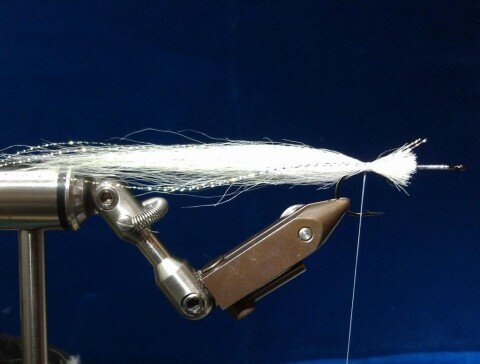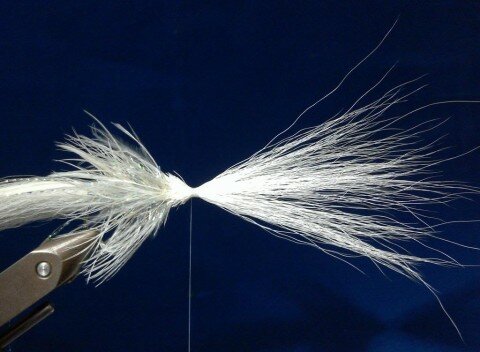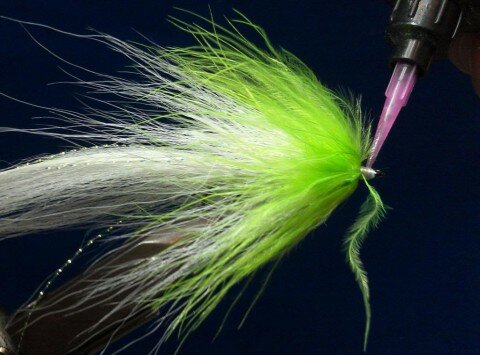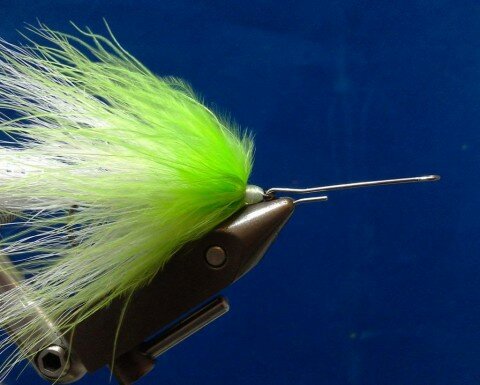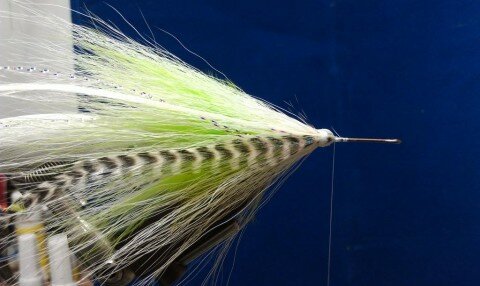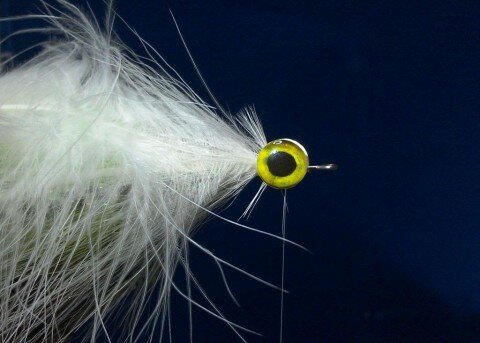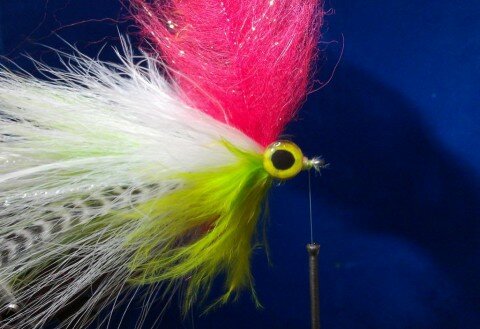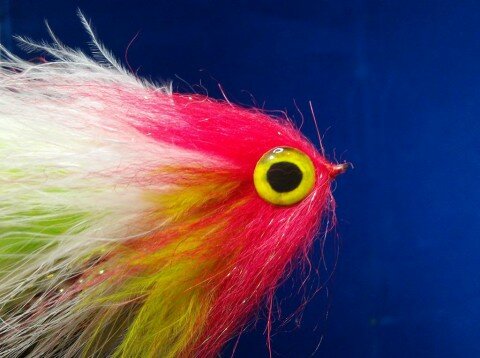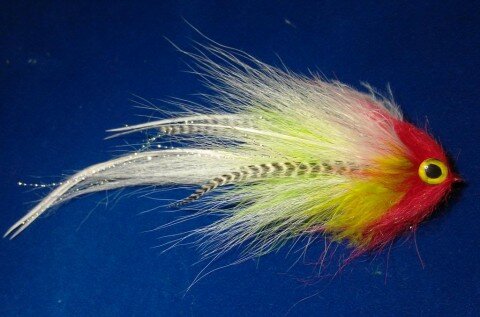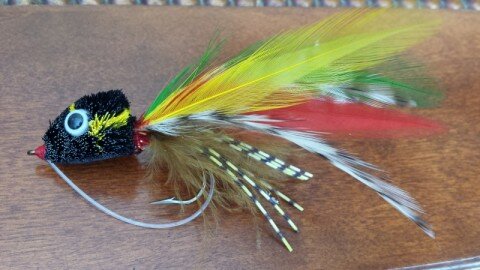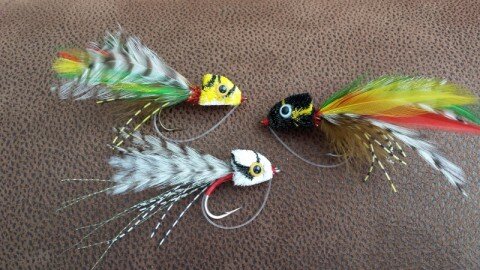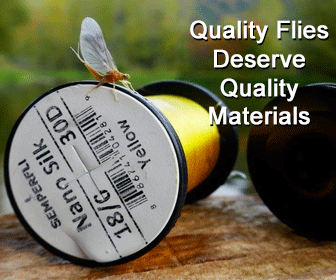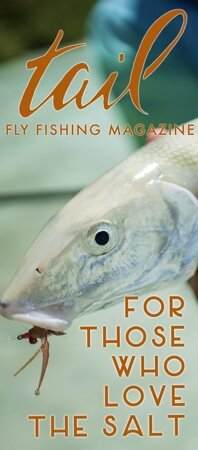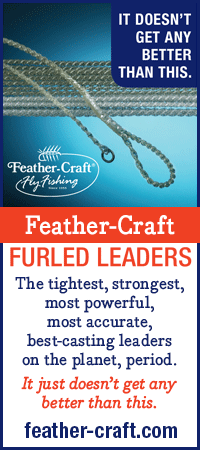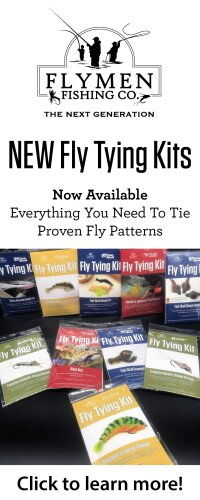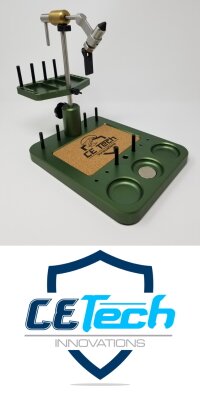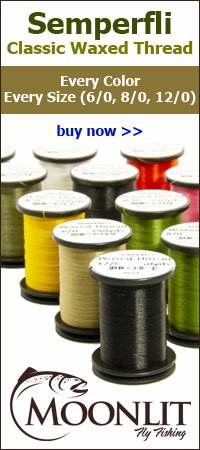
Arkansas River Tailwater in Pueblo
Juan, for those who are not familiar with you, could you tell us a little about your fly fishing background and how you became interested in fly tying?
When I was in the 4th grade, we had an overnight camping trip at a local park which had a pond at it. That was the first time I ever fished. I guess you could say that I was hooked. After working to get a “pole”, I tried to fish as much as possible. Growing up on the Plains, just west of the Sangre de Christo Mountains in Northeastern New Mexico, my local fishing areas were the warm and muddy waters which held catfish and not the trout that were further upstream in the mountains. I fished as much as I could. I went through a few outfits that first year and I am still trading out rods and reels to this day. I learned, very early, the lesson of catch and release. After a summer of catching and keeping all the fish I could, there were very few fish left. There were days where I didn’t catch anything. From that summer on, I always released most of my fish. After moving on to pike and trout at a local lake, I found bass in the same lake. Man that was awesome! I was still throwing minnows and spinners, but it was still fun. After finishing high school, I ended up in Durango, Colorado. Not a bad place to be if you fished. At the time, I didn’t know how to fish a river, although a few years before I did fish the Animas River right in town and caught fish on spinners and that may have had something to do with the decision to go to college there. Towards the end of my college years, I was pretty good at the throwing spinner thing and had some friends that fly fished. I got a quick casting lesson and never looked back. I moved back to New Mexico and started fishing the local streams with both spinners and flies. Soon the spinning rod was staying home. I learned how to fish the local lakes and was 1/16th of an ounce off of the NM state record for yellow perch. I guess I should have stopped fishing and got that thing weighed sooner rather than later.
Tying flies came naturally after getting into fly fishing. I was mentored by a great fly fisherman and tier. I made leaps and bounds with both tying and fishing. Soon, I was guiding on the Cimarron River and learning a ton about the industry. While in NM, I built a great base for my next adventure. A move to Colorado Springs in 2006 placed me near some great rivers. The South Platte River and the Arkansas River were nearby. These 2 rivers have taught me a lot over the years. Also being exposed to and able to tie with some of the world’s great tiers taught me what it took to be good at something. Currently, I am guide for Anglers Covey in Colorado Springs, a member of the design team with Montana Fly Company, on the Pro staff of Regal Vises and on the Pro Staff of Deer Creek Flies based in the UK. Throughout all of this, I have had the blessing of having an amazing wife who may never understand my craziness, but continues to put up with it.
What can you tell us about your home rivers, the South Platte and the Arkansas River? Are there particular hatches on these two rivers that are more productive than others?
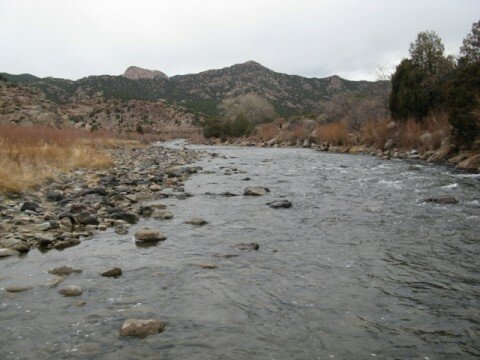
Arkansas River
The Arkansas River is my favorite. It’s a freestone and has many miles of public water. It’s about an hour from Colorado Springs, but most of it is at least an hour and a half or more. In the spring, it wakes up with BWO hatches as well as caddis and stonefly nymphs moving around. Around April, things get really exciting as the bugs are really going. By May, it’s still going strong and only getting better. After run-off hits in mid-May, things settle down with great streamer and attractor fishing all the way into fall. Fall brings back the BWOs and streamer time. It’s such a great river; I just don’t have enough time to spend on it. The Ark gets a lot of attention for the caddis hatch, but the BWO hatches are, in my opinion, much better and more consistent. Plus, they happen twice a year!
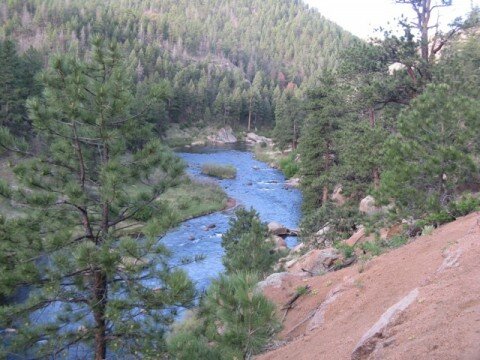
Cheeseman Canyon
The South Platte River is unique. West of Colorado Springs, there are about 9 stretches of water to fish, as well as 3 reservoirs to fish. Stretches include the “Dream Stream”, 11 Mile Canyon, Cheeseman Canyon and Deckers. Each one of these is world class and will teach you a lot. There is open meadow water, canyon pocket water and spring creek like flats. The best hatch here is the trico spinner fall. It happens on all 4 stretches of the river. I think 11-Mile Canyon has the best spinner falls though. The fish really love eating the spinners and they happen from late June all the way through October. In the summer, I’ve really started liking the PMD hatch. It’s a pretty consistent hatch that happens after the spinner falls during the summer and I have found the fish will continue eating throughout the day, eating lots of PMD emergers. The BWO hatches are great as well. They are super small though. Right now, they are about a size 24-26. I love fishing emergers before and during the hatch. Some fish will only eat nymphs and emergers as to not have to eat off the surface.
The other section of water that is great is the Pueblo Tailwater. Several years ago they invested some time and money in the Arkansas River that runs below Pueblo Reservoir and through the City of Pueblo. It has paid off as this is a great piece of water during the fall and winter. Last year was fantastic during the summer and this year had its moments as well. It holds some really nice fish and as long as the flows are steady, the fishing is usually great.
How did you get the nickname Hopper Juan?
When I first moved to Colorado Springs, I made the rounds in the local shops trying to fit in. I did some things here and there and some people started to remember me and that was around the same time that I was pushing the hopper pattern and the blog. Before I knew it, people were calling me Hopper Juan, the name of my pattern and my blog. It has stuck and while there are not a ton of people that call me that, some still do. I enjoy it and appreciate it.
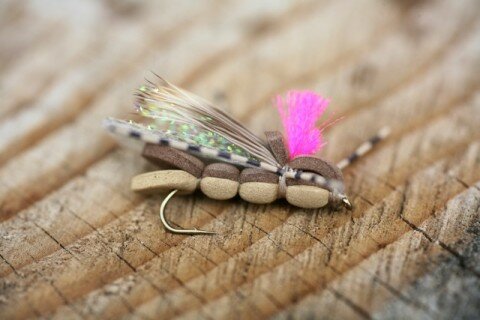
The Hopper Juan
What are some of the best ways to fish a hopper?
I often start fishing the hopper in early spring. I know that there are no hoppers out in February, but that is not what I am expecting. On the Arkansas River above Canon City, CO, the water is low and clear in early spring. In late February, the BWO nymphs are numerous and are just starting to become a more important food source for the fish. After eating mostly midges during the winter, the sight of drifting baetis nymphs must be a sight. I still like to use a nymph rig for the deep dredging of stoneflies and midge larva, but as soon as there is a temperature rise and fish become more active, I like to fish with a dry/dropper. The fish may move up to feed on drifting BWO nymphs in the riffles and adding a heavy dropper such as a Copper John or a stonefly nymph followed by a Randy’s Baetis or a 719 Baetis nymph may just be the ticket. I can fish closer and have more control over my flies than a nymph rig. Also, fish may be nosed up in warmer, shallower water picking off a few bugs in about 6” of water. By putting a dry/dropper rig over those fish, you have a less chance of spooking them. I would rather use a smaller caddis or mayfly dry at that point, but if you are already rigged up and only have one rod with you, then chances are that you don’t want to change out and chances are that you might get that fish to eat one of your bugs.
As early spring moves into late spring and early summer, I can still use the same rig to target fish eating BWOs and caddis nymphs. Over the last few years, I have hit more days where the fish were keyed into the BWO emergence and not the duns. This is usually due to the fact that the bugs are out and so is the sun. The fish can eat right below the surface without having to expose themselves up higher in the water column. As the fish move into the upper third of the water column, you can see them feeding on nymphs and emergers, but they are too high to use a nymph rig and to deep to use a small dry like a Parachute Adams with a dropper that will not get down deep enough to them. This is where I like a hopper on top followed by a tungsten dropper like a Glossy Back or a 2 Bit Hooker to get down in front of their faces. I then follow that with a more impressionistic pattern like an RS2 or a Foam Back Emerger. This set up works great and adjustments can be made by the length of your dropper tippet.
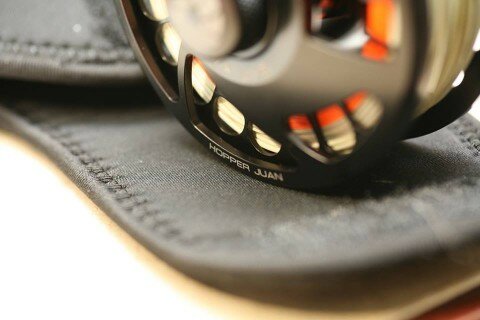
In the early summer, when runoff has the flows higher, there is a time and place for the same set up. When the South Platte is running higher than normal, a lot of those fish retreat to the banks where they can still eat without having to exert too much energy. This means the pocket water that has been created by the higher flows and close to the banks. Again, a hopper pattern followed by a heavy stonefly or heavy mayfly pattern thrown up against the bank where a 6”wide holding slot holds a fish can mean the difference between a couple fish and a couple of good fish. I know a spot near Deckers that has always held a nice fish, up against a rock, where only a rig such as this one has been able to get the fish to eat. The fly needs to get in front of their face in order for them to eat. If they don’t see the dropper, they won’t eat it. As the water starts to drop, the fish settle down into a more normal summer routine. On the S. Platte, flows can move up and down like the stock market. Fish move according to these ups and downs. When flows are more stable, fish are more stable. I like to fish those spots that most people miss because they are fishing a nymph rig. Those slots behind small rocks are everywhere in the summer and the fish are in there. The beautiful seams become more defined and knee-deep water is everywhere. I can target those fish with the dropper; again making sure it is heavy enough to drop in front of the fish and matches something they are eating. I love those slots about 6” wide and knee-deep. I have pulled some really nice fish out of those places when a nymph rig would have been too much. A dry/dropper rig is more precise and I have more control over it in those situations than a nymph rig. Also, how many times have you seen a fish feeding in the hydraulic cushion in front of a rock? The one time I tried to use a nymph rig, I ended up having the flies go one way around the rock and the indicator going the other way. After breaking off the rig, losing everything and scaring off the fish, I decided never to try that again.
By late summer and early fall, I have already targeted the BWOs, Caddis, Stoneflies and PMDs with this set up. The Hopper Juan was designed as a hopper and while it is not the answer for everything and doesn’t exactly look like a hopper, it makes a fine imitation. As many of you know, here in Colorado and more specifically, the S. Platte, it’s not known as a huge hopper river. Sure they are around and fish eat them, but it’s not like fishing in a Montana meadow stream. I didn’t specifically design this pattern for a particular stretch of water. I designed it to work as more of a problem solver pattern. Those situations I mentioned above led me to find a pattern that floated well and caught fish and held up well after a few fish. While I do love plopping this pattern on the water and hoping for a fish to smash it, generally that is not the case. I enjoy watching it float along perfectly on the water’s surface, only to be jerked down by a fish eating the offering below the surface. Either way, as long as there is some action and fish are landed and released everything in my world is right. The really good days are when you only fish the hopper and a dropper is not needed.
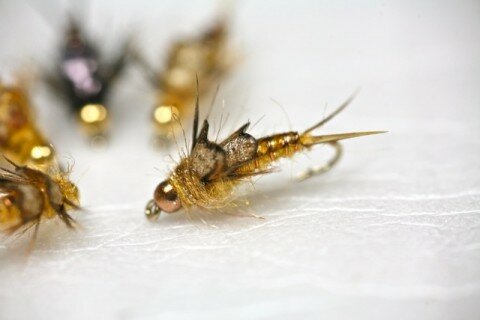
Juan’s Golden iStone
This sometimes happens earlier in the season when fish are keyed into the Golden Stoneflies. Again, more often than not, they like to eat the bug below rather than bug on the surface.
As fall gives way to colder water and lower flows, this set up again proves its worth by being able to hit the nook and crannies where fish are feeding. Usually at this time fish are on the feed before spawning and winter. Big nasty streamers are great fun during this time and are effective. By late fall, the hopper/dropper set up is replaced by the standard nymph rig for fishing the deeper water where the fish are waiting for the baetis nymphs to start drifting again and the cycle begins again.
While I prefer to use a Hopper Juan for this style of fishing, please don’t think that this is the only way to fish it. I generally use a size 8 to hold up most of my droppers. When I tie the flies, I always finish it with a good waterproofing material such as Water Shed. I cannot stress how important I think this is. While foam floats great, once you put everything together; foam, elk hair, wing material, thread and a water absorbent antron wing, it tends to take on water and sink. By adding a waterproofing agent, along with some floatant, it will repel water and keep on floating for a long time. Without a good waterproofing, it tends to sink in rough water or if you have too much weight off the back end of it. Again, you can use any fly you like to use in this system. I often use an Amy’s Ant, a Chubby Chernobyl, a Club Sandwich or a Fat Albert in place of the Hopper Juan. When fishing in smaller streams, I often downsize my offerings. A size 10 or 12 works better and is better suited for the smaller fish. I also like to use a Juanna Be Hopper Juan which will hold up a small tungsten dropper and allows the small Cutts and Brookies to get it in their mouth.
Whatever fly patterns you choose to use and whatever style of fishing you choose to do, just remember to have fun. It’s the reason why we tie and why we spend time standing in a river waving a stick.
Could you list your own hopper fly patterns?

The Hollywood Hopper
I currently tie 2 of my creations along with other patterns created by others. The Hopper Juan was created in 2007 and the Hollywood Hopper has been around since 2008. Both patterns were tied and fished with before they were revealed to others. Before the blog world and Facebook, it wasn’t too hard to keep things quite. With social media, a new fly pattern can become quite popular in a matter of days. Once I placed these online, things took off.
The Hopper Juan was created to solve a problem. It was tied as a buoyant hopper and relied more on the dropper than having fish look up and eat it. With more time on the water, more fish started eating it on the surface. I still prefer to fish it in a hopper/dropper set up and it still catches fish pretty well. The Hollywood Hopper was created to be more realistic and to offer myself another option to the Hopper Juan during the summer. It has worked out quite well. The Hollywood Hopper sits lower in the water and accounts for more of the pickier fish than other hopper patterns.
One other pattern I love is a spinoff of the Hopper Juan. It’s called the Juanna Be Hopper. It’s much smaller, used as a single hopper pattern or for the smaller streams and smaller fish. Think Cutthroats and Brookies in the mountain streams. I often tie this on a standard dry fly hook for fishing the smaller waters as the smaller fish can eat the pattern easier than if it had a bigger hook. If I am throwing a smaller hopper to bigger, stronger fish, I often tie it on a TMC 2499-SPBL hook as the gap is quite wide and the hook is strong and holds the bigger fish better.
Do you ever use any classic hopper patterns?
I used to use the standard hopper patterns like the Schorders Hopper and Dave’s Hopper and the Whit Hopper. I have had great days with each one of them, but over the last few years, I haven’t fished any of them. I usually fish foam patterns. Some of my current favorites are the the Morrish Hopper, Kyle’s King Kong Hooper and Trina’s Carnage Hopper. A lot of people still love the classics and hate foam patterns, but I love it and I now only tie and fish foam patterns.
What hopper do you fish the most?
I would say the Hopper Juan. I use it as a hopper/dropper set up as most of the time, the dropper catches the fish. On the South Platte, there isn’t a ton of fish waiting around for hoppers. I have had many great fish caught by running a hopper dropper set up with the fish eating the heavy dropper. If it weren’t for the buoyant hopper, the dropper would pull the top fly under and it would not be an effective set up. I fish the hopper/dropper in really tight windows. Just this last week it caught a nice fish in fast water where I only had 2″ of calm water against a rock face. A good cast placed the hopper in slow water and the dropper sank right to the fish’s level.
I carry several patterns with me during the summer and right now I carry the Hopper Juan, The Hollywood Hopper, Amy’s Ant, The Chubby Chernobyl and Kyle’s King Kong Hopper. I would carry more, but why? That’s enough for the waters I fish.
What are some of the other types of flies you like to tie?
I love tying the small stuff. I enjoy tying RS2s and try to make them better each time I tie them. That’s for me, not the fish. Fish will eat ugly flies and they don’t care how beautiful your fly is, it’s just food to them. I tie a lot of midges, BWOs, Golden Stones, PMDs and trico patterns. Almost all of the flies I tie are trout flies. I don’t stray too far from them. I haven’t fished for other species much in the last few years. There aren’t a lot of other options that I take advantage of nearby. I guess I should make an effort to target other species a bit more, but haven’t yet. I used to tie more pike flies, walleye flies and bass flies when I lived in New Mexico, but here, I have only tied trout flies. I’d say I love tying Pheasant Tails, Parachutes and tying with CDC. CDC isn’t a new material to me, but I have been using it in different ways the last year or so. I love it!
Do you have specific flies you carry when guiding? If so, could you name a few?
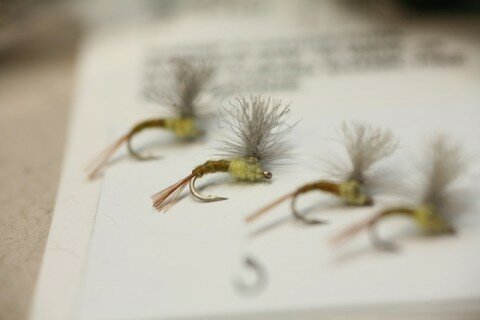
#18 PMD Parachute Emerger
If you see me on the water, you may think I was a member of the SWAT team. I carry a bunch of things with me while on the water. I have a Fishpond vest along with a Fishpond pack. I carry a small 1st aid kit along with several fly boxes. Most of the time I only work out of one or two boxes, but there are those days where I need every pattern in almost every box. With more experienced anglers, I use more patterns as we can target more difficult fish and try to fool them. With beginners, I often only use a few flies. During the spring, I use a lot of caddis and mayfly nymphs along with eggs and San Juan Worms. In the summer, I always have trico spinners down to a size 26. I also use a variety of PMD patterns. On tail waters during the summer, it really doesn’t change much from day to day, so I rely more on presentation than extreme fly selection. Hoppers don’t get pulled out too much on guide trips but if I feel like the client can handle it, I won’t hesitate to tie one on. During the fall, I switch to a lot of BWO patterns as well as eggs. If I had to pick 2 flies to use year round on the South Platte, it would probably be a San Juan Worm and a #22 RS2. Some days it doesn’t get to exciting on fly selection!
What would you say were your “go-to” flies or the flies you have the most confidence in?
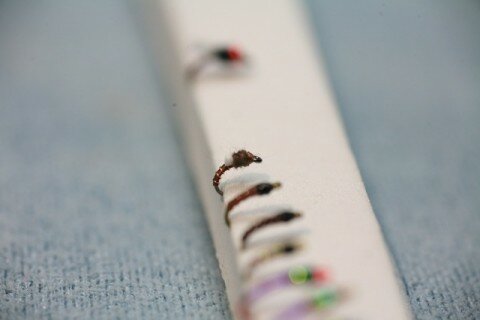
#26 Chocolate Foam Back Emerger
I can say that I won’t ever be without RS2s in various sizes and different configurations. I like the standard antron wing style as well as the mercury style and sparkle wing style. Gray is my most used color. Other go to flies are the Chocolate Foam Back Emerger in size 20-26, my Tungsten Glossy Back Baetis in Rusty brown as a dropper in a nymph rig as well as a hopper dropper set-up. Size 14-20 are what I use. BH Flashback Pheasant Tails are also one of my favorites of all time as are BH Prince Nymphs. The Wooly Bugger in black is one that I will always carry with me and if I only had one fly for the rest of my life, this would be it.
This summer, my solid go to flies were a #26 Trico Spinner and a #26 Foam Back Emerger.
Would you mind describing a couple of the rigs you use when fishing your main rivers? Including the rod, reel, line, and tippet?
I fish two rods these days. My personal rods are all Hardy Zeniths. My guide rods are Helios 2s.
For most of my fishing, I use a 9′ 5wt rod. There are days where I like to use different rods, but it usually comes back to a 5wt. I tell beginners that a 5wt is like a 30-06. It gets a lot of things done and if I had to pick one size for my part of the world, it would be a 9’5wt.
A typical day on the South Platte or Arkansas River has me starting out using a 9′ 5wt to throw a nymph rig. I use 2 flies, split shot and an indicator. On the Ark, as we call it, I use golden stoneflies as an attractor followed by a caddis or BWO depending on the time of the year. On the South Platte, I use an egg or San Juan Worm as an attractor followed by a midge larva or BWO. When the adult BWOs are out, the 5wts can do the job, but I prefer to go lighter. A 4wt rod is
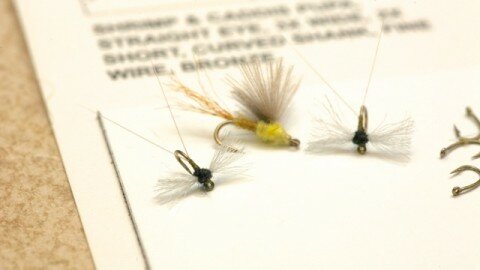
#26 Trico Spinner — #18 CDC PMD Dun
perfect for throwing dries. During the Trico spinner falls on the South Platte, a soft light rod is great for making the close casts. I like a 8’6″ 4wt. Zenith or a Scott G2 8’8″ 3wt (my 3rd rod choice). On the Ark during the summer, I throw more attractor dries and hopper dropper patterns so the 5wt is used the most but a 4 or 6 wt is also a good option. Later in the fall, I like to use the lighter rods, but often find myself using one rod. The reason I love the Zenith rods is I can nymph with them and switch quickly to dries and not miss a beat. These rods are great at everything. In the past, I had a great nymphing rod, but it lacked the feel up close. These days, I have the rods that can do it all and I don’t feel like I am left wanting a different rod in my hands. I use Nautilus FW/FWX reels as well as Lampson reels. These two companies make a great product and I have no reason to doubt their quality while using them. I use Rio fly lines on most of my reels. I also have some SA lines that I use on certain rods. Recently, I have started using a Rio Perception line in 5wt. So far I have been very impressed with it. It feels great, cast great and I really do think it is a much better line than regular lines. For leaders I use Orvis and Rio and I use Orvis Mirage and Rio Flouro and Powerflex tippet material. I have used Rio for years and I am pleased with them as a personal and guide choice.
For those of us who are not familiar with fishing midges, could you suggest a technique you use?
In the Southern Rockies, the most common nymph rig is 2 flies with weight and an indicator. I use this 99% of the time to nymph. When fishing midges during the winter, I use an egg pattern or something “bigger”, say a size 18 PT nymph and a #24 midge larva or midge emerger. This is fished with weight about 8-12″ above the first fly and an indicator about 6′ between the indicator and weight. In lower water levels, the indicator and weight are all adjustable as needed. When fishing dries, I use a 9′ leader and a dry fly like Matt’s Midge or any of the small midge patterns that are unnamed out there. We fish with nymphs a lot during the winter. It’s the only game in town for most of us. I also set up a dry/dropper as needed to keep the presentation as small and natural as possible. In low, clear water an indicator and split shot can spook a lot of fish. I keep it small and simple. I also try to keep the flies as natural as possible although when I think I have it all figured out, they love eating a #18 shinny Rainbow Warrior. A little flash is good to have, but I also make sure to carry Disco Midges for those days when the fish love a little bit more flash.
Please tell us about your new Hopper Juan kits. What are they and where can they be purchased?
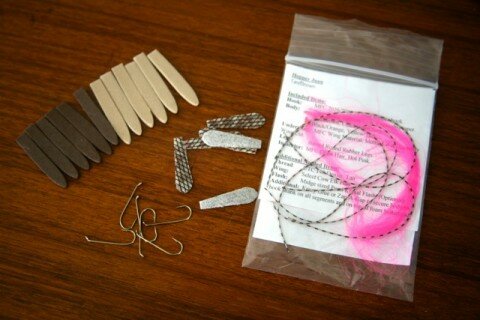
The Hopper Juan tying kit
As I was doing all these demos and tying this pattern, I always got the question “where can I find all the material to tie these?” I would have to tell them that this shop carries this material and this shop carries this material and you might have to on-line to order this material. Thinking about what I said, I figured as a tier, I wouldn’t go through that trouble to tie this pattern. My wife actually suggested that I put together kits for the pattern. I was able to get all the materials together and package them up and I was able to offer the tier a way to tie my patterns easier. The kits contain 6 hooks, rubber legs, pre-cut foam bodies, indicator material and the over wings, I like to use. One of the biggest problems I had with this pattern was that people didn’t want to shell out $15.00 for one size foam cutter if they could find one. I pre-cut all the foam and include it in the package. I wanted to make it easy on people and I wanted them to tie and fish my pattern. The kits have made it easy.
Every year around Christmas break, I gather all my material and get to work creating the kits. I take them to the Denver FFS and sell them there. It helps to cover my gas costs and food. I sell about 50 kits each year and this year I sold them all. I will have more available at the first of the year. I just need an e-mail request and I accept Pay-Pal.
What have you been working on at the bench lately?
Lately, I’ve only been re-filling my own fly boxes and that is limited to only a few patterns. I’ve been guiding and doing beginner classes a lot this summer and with the beginners, I keep it simple. Mostly San Juan Worms and RS2s. Those are easy to tie and they work for me. I usually tie to solve problems on the water. While guiding beginners, there may be problems you run into, but I am usually more involved in teaching them how to cast correctly rather than trying to land a # 26 trico on a fish’s head. With that, I haven’t really been too creative. I haven’t been able to spend a lot of time on the water and right now, I am just trying to keep up with the massive loss of flies from the beginners. I’ve also been tying some custom flies for people here and there, but not a lot. I also need to get my next batch of submittals over to Montana Fly Company for next year’s decision. I have a few great patterns, but what works for me may not be what works for other people. It’s always interesting as to what they think will be hot sellers.

Juan on the Arkansas River
What was the last fish you caught and what were you using to catch it?
This week I was at Deckers and I fished a hopper/dropper set up. There is a spot where there is a large rock and if you hit it just right, there is a cushion of “soft” water. If you can get your dry fly in that sliver of water, your dropper has a chance of getting in front of a fish. I hit it just right and was rewarded with a nice solid fish. It wasn’t the biggest fish of the day, but it was the hardest fish to get to.
-

- At the Denver Fly Fishing Show 2013
-
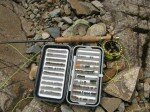
- Flies and rod Hermosa Creek
-

- Guiding on the South Platte River Summer 2013
-
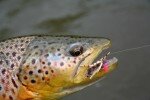
- Hopper Juan getting it done
-
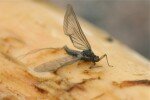
-
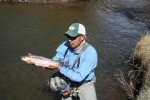
- Summer 2013
-

- The Lil Hollywood Hopper
